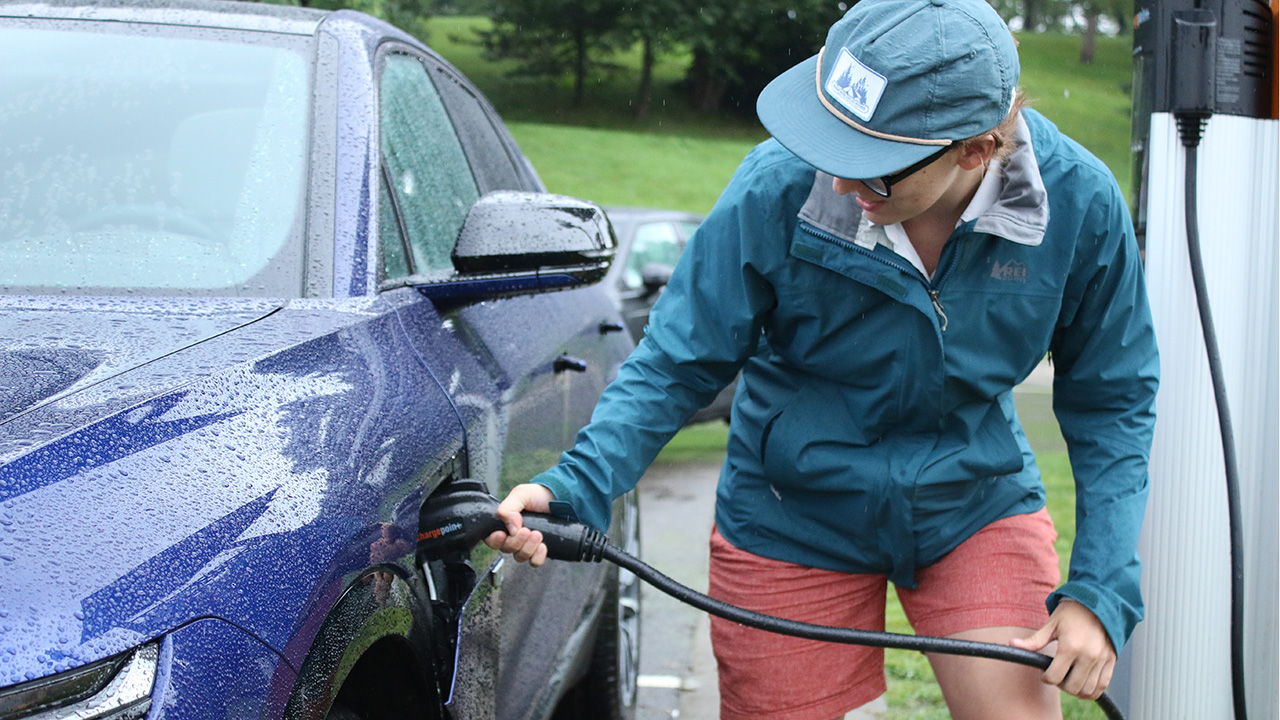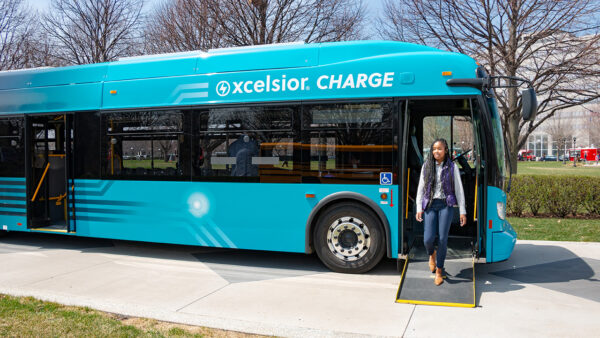
As electric vehicles (EVs) continue to grow in popularity across Minnesota and consumers have access to over 100 electric vehicle models, many drivers are curious about making the switch to electric. And curiosity brings practical questions about EV ownership. To help answer these questions, Fresh Energy brought Jukka Kukkonen, our transportation consultant and founder of Shift2Electric, Anjali Bains, managing director of transportation, and Nick Haeg, senior associate, electric vehicles, onto the Decarbonize: The Clean Energy Podcast hosted by Jo Olson, chief communications officer, to talk about EVs and answer listeners’ questions about them.
From charging basics to winter driving tips, Jukka, Anjali, and Nick draw on their extensive EV knowledge to help Minnesotans figure out what matters most to prospective and current EV owners.
Read a few selected EV questions from our audience below, and be sure to listen to the full conversation on our podcast!
This article has been edited for length and clarity.
What’s the state of the electric vehicle market in 2025, and how does Minnesota fit in?
Jukka: I first like to share that we already hit peak internal combustion engine (ICE) cars back in 2017. Since then, we’ve seen a steady, clear trend of ICE vehicle sales dropping, especially in recent years. Globally, EV sales are growing steadily. China has the largest automotive market and has seen rapid EV growth. Over 10 million EVs were sold in China in 2024, more than 50% of the total vehicle market. In smaller markets like the U.S., EVs are growing but not as quickly, likely due to the economy, higher interest rates, and other vehicle market variables. It’s quite clear when you look at global vehicle sales that EVs are the future of the market.
In the U.S., the EV market has slowed down but is still growing, especially after a very strong December. Here in Minnesota, over 10,000 EVs were sold in the first six months of 2024 alone. That’s more EVs than were sold in Minnesota in their first six years! We don’t yet have the complete data for the year, but we expect that 20,000 EVs were sold in Minnesota in 2024, which is roughly 8% of the vehicle market. As more people test electric vehicles and Minnesota builds more charging infrastructure, I expect more and more Minnesotans will be driving EVs.
Anjali: Electric vehicles are an important way to decarbonize Minnesota. The transportation sector is the largest contributor to climate emissions in Minnesota, the U.S., and the globe. Within that sector, personal vehicles make up almost 55% of those emissions. That’s why decarbonized methods of transportation, like EVs, are so important.
At Fresh Energy, the transportation team’s strategy focuses on decarbonizing the movement of people and goods. We prioritize affordable, accessible, and zero-emissions technology and infrastructure, as well as a precise deployment of low-carbon fuels when necessary. Lately, we’ve been focusing on expanding the adoption of personal EVs and EV chargers, especially public and at-home charging. We’re also advancing school bus and transit bus electrification, too.
Nick: As the senior associate of electric vehicles, much of my work is advocating for more supportive EV policies at the Minnesota Public Utilities Commission. I’m looking forward to Minnesota Power’s new pilot program on EV charging for multifamily dwelling unit buildings, which is a hurdle that affects roughly one in four Minnesotans from getting an EV.
Should I start with an electric vehicle or a plug-in hybrid, and what resources are available to me as a first-time buyer?
Jukka: Well, my recommendation is always to talk with an EV owner you may know and ask what it’s been like to own, drive, and charge their EV. They’re always the best person to get information.
You can also find great information on the EVInfoList, a website that’s a great resource for potential buyers with more information.
There’s also the MN EV Owners group on Facebook, which is one of the biggest and most active regional EV owners’ groups in the U.S.
Does repeatedly using a DC fast charger for my electric vehicle have a negative effect on my EV’s battery life and performance?
Jukka: No, using a DC fast charger often doesn’t have a noticeable impact on the life and performance of your EV’s battery. Some heavy EV users in Europe, like taxi drivers using an EV in warmer countries, have noticed a slight negative impact from solely using DC fast charging, but this does not apply to personal EV drivers. If you’re curious, you can get an EV battery report to see the state of your EV’s battery health.
What should I do about my Nissan Leaf with decreasing battery capacity and range? Will the old batteries be recycled?
Jukka: Even when the range is lower, you still often have 70-75% of the battery left, which can make it challenging for longer-range trips but perfectly accessible for a car you use for commuting. We’re also seeing new third-party options for replacing your vehicle’s battery. Our friends at the Foreign Service in Roseville and now doing upgrades to Leaf batteries to replace your old battery with a newer one, easily doubling your Leaf’s EV range.
EV batteries will always be recycled. None of them are sent to the landfill. When you decide to replace your battery, the old battery will most likely get a second life as a stationary storage battery, then be recycled perhaps a decade later.
What special considerations are needed in Minnesota’s cold climate regarding EV batteries and range?
Jukka: Overall, you need to be aware that your EV will have about a 30% drop in range in a worst-case scenario during Minnesota winters as a result of the cold weather. You may want to take that into consideration when you are shopping for an EV, considering how far you will often have to drive it so you can purchase an EV with a range that will work for you even in cold weather.
In the wintertime, simply keep your car plugged in, preheat it in your garage to maximize efficiency, comfort, and charge it along the way as needed. We have an entire blog post that has more resources about owning an electric vehicle in a cold-weather state like Minnesota, and another with tips about driving your EV over longer distances.
What are “too good to be true” red flags I should keep in mind when in the market for an EV, particularly with EV lease programs?
Jukka: I would start by looking at the vehicle manufacturer’s website to see what they promise, then start calling car dealerships to see which have the vehicle you’re looking for. If your main criterion when purchasing an EV is its cost, your best path forward is to call dealers and see what’s available and at what price. That way, you know that you’ve done your homework, you’ve located dealers that have a vehicle you’ve liked, and you can have confidence that you’re entering into a financially safe agreement.
I heard that some car dealers are complaining about having to be forced to sell EVs. Have we seen more cooperation from Minnesota car dealers lately, especially after the Clean Cars law passed?
Jukka: It’s important to know that the car market as a whole has slowed down a bit, and car dealers have had challenges because of that. This is a cyclical trend that we’ve seen happen many times in the past. Sometimes sales will be high and selling is easy, and sometimes it’s slower and harder; plus, some vehicle models become more and less popular over time. These cyclical trends create challenges for dealers, who can be very opinionated.
Anjali: It’s also important to remember that a model year doesn’t always line up with a calendar year. So because the Clean Cars rule is in effect through model year 2025, a lot of those cars were actually sold in this current calendar year. So we are seeing the effect of the Clean Cars rule by seeing more dealers carrying more EVs on their lots. Clean Cars required at least 8% of EV sales to be electric by model year 2025, which is about the level of sales we saw in 2024—and that’s resulted in more dealers carrying EVs on their lots for consumers to shop and purchase. It’s great to see that the Clean Cars law has helped consumers have more choice with what vehicle they decide to purchase.
How important is it to match your Level 2 charger amperage to your car charging amperage?
Jukka: It’s not imperative that the two match, as the car will match whatever the charger provides, but the higher your charger’s amperage, the faster your car will charge (up to its charging capacity).
Usually a car’s slowest rate of charging is 3.3 kW, and nowadays the most common is 6.6-7kW, with some cars even having 11 kW of charging. I believe the Ford F-150 Lightning is capable of a 19.2kW charging speed. In order to ensure your car can charge as quickly as it’s able, you’ll have to make sure the power capacity of your house and charger can support it. If you have a 50- or 60-amp service, you might be limited in charging speed; the car will still charge at lower amperages, it will just take a little longer. If you have older 100-amp service, you should still be able to have Level 2 charging installed, but not the highest-power ones.
The important thing to remember about home charging speed is that it really comes down to how you’re driving your car. If you drive, say, 50 miles a day, you could get by with a 3.3 kW charger. If you’re driving a large F-150 Lightning for 150 miles a day, then I’d probably get a higher-amperage rating to charge it up each night. In the same way that it’s important to purchase an EV that best suits your individual driving needs, it’s also important to have a charger that can charge your vehicle more quickly if you plan to frequently drive it for longer distances.
Do electric vehicles’ tires wear out more quickly than gas cars?
Jukka: Since EVs are generally 10 to 15% heavier than gas cars, they do wear out the tires about 10 to 15% faster. The extra weight can be a helpful thing during our winters when the roads get icy or slippery. It’s important to take that into account, but also important to remember that EVs cost much less to maintain and charge compared to their gas counterparts. Like all cars, you should rotate your tires from time to time to ensure they wear evenly.
Are there initiatives to reduce the financial and operational barriers for owning and operating DC fast chargers for small businesses and fleets?
Jukka: Many electric utility companies will provide technical assistance for DC fast chargers, so you should start there if you’re thinking about putting DC fast-charging infrastructure in place. They’ll be able to tell you what kind of capacity is available in your area, what might be the best location, and make it more affordable to install.
Some utility companies also provide incentives for installing DC fast chargers. Some may have what’s called a “make-ready” program, where if the location is right, the company might provide the power all the way to where you’re installing the charging station, which makes it much easier for you.
Other utility companies may have commercial rebates that provide incentive funding for the process to invest in new transformers, line extensions, or similar electrical infrastructure.
Anjali: I know the electric utility Minnesota Power specifically is proposing “make-ready” infrastructure, “make-ready” rebates for workplace, fleet, hospitality charging, and public charging in their filing later this week, along with its multifamily EV charging pilot program.
Xcel Energy does have a commercial EV fleet pilot program, and there will be discussions in the next year as Fresh Energy engages with Transportation Electrification Plans on how to make these programs permanent. We’ve been making the case to not only focus on public and non-profit entities, but to also include commercial entities, especially small business, to expand these programs beyond the pilot phase.
What’s next?
Whether you’re considering your first electric vehicle or are looking to maximize your current EV’s performance, the transition to electric transportation comes with many questions. We’ve only scratched the surface with a handful of answers in this blog post, and you can hear even more insights from Jukka, Anjali, and Nick by listening to the full podcast episode. Their detailed responses to additional questions about EV ownership, charging infrastructure, and Minnesota’s clean transportation future will help you better understand and join the EV revolution.


